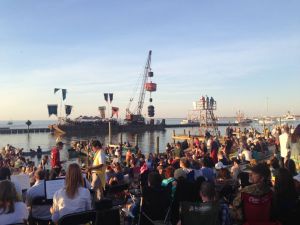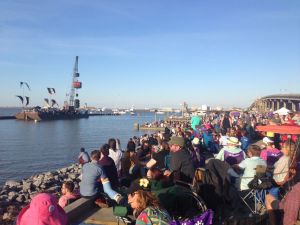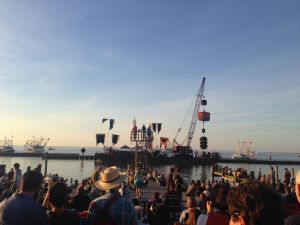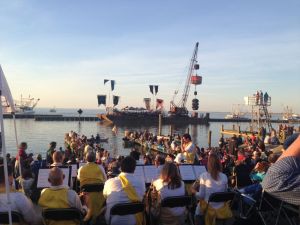New Water Music
George Frideric Handel composed Water Music in 1717 to celebrate an aquatic journey of King George I along the River Thames. While the King traveled along the water in a royal barge, the orchestra followed behind in a barge and performed the piece. This floating orchestra was in part the inspiration of the spectacle musical work New Water Music by composer Yotam Haber, which was performed in two variations this past April in New Orleans. Stylistically the two works are not related, but they are both very much of their time and place.
South Writ Large had the once-in-a-lifetime opportunity to attend the two debut performances of New Water Music. The Louisiana Philharmonic Orchestra performed a twenty-minute indoor version of the piece on April 6, 2017, at the Orpheum Theater accompanied by a silent film created by Canadian filmmaker Isabelle Hayeur. On April 8, 2017, at dusk, Yotam Haber conducted the hour-long New Water Music on the waters of Lake Pontchartrain while the piece was performed by several hundred community musicians, including both amateurs and professionals. There was an audience of thousands in attendance, and some onlookers even watched from the water while they swam.
To set the scene: Haber was stationed in a lifeguard tower facing the water with two assistants who waved specially created flags like conductor batons to signal changes in the piece. They overlooked a massive and motionless barge, which held the string musicians and accordion players and was the epicenter of the piece. A fleet of shrimp boats carried other musicians (the woodwinds, the high brass, the low brass, and the percussionists) and moved about the water in a highly choreographed manner. The boats were manned by local fishermen and shrimpers hired for the piece. Haber’s official partners in this enterprise were the Louisiana Philharmonic Orchestra and the arts organization New Orleans Airlift.
Yotam Haber generously spoke with South Writ Large about his original―and epic―composition in advance of the two performances. At that time, it was unclear if the piece would be as successful as it ultimately was.
How did the idea for the piece come about?
I wanted to write a piece that was a chamber work written for eight local New Orleans musicians. I knew that I wanted to do something that was more than a chamber work where an audience sits in a hall and listens to the piece while the musicians are on stage and that’s the end of that. I wanted to do something that was more site-specific and really tied to New Orleans. I would say my career is about writing music that is very specific to place, geography, community . . . The idea then grew and grew and grew and grew and these eight musicians, as much as I love them, decided it was a little bit beyond their scope. So, we decided to just expand the idea and make it for an orchestra, for the Louisiana Philharmonic, and include as many community musicians as we could get to perform as well . . . I was going to write a piece that was not just for a professional orchestra, but also for musicians of all skill levels and also all traditions and backgrounds and, in fact, use the strength of all these rich New Orleans musical traditions that are certainly not my traditions. So there is a lot of freedom in the score for local musicians to do what they do best and use rhythms and melodies that they’ve grown up with. Audiences, especially local audiences, will recognize snippets, things that they know very well—Mardi Gras parades, second line parades.
Did you put a call out for community musicians, or did you solicit particular people?
The answer is absolutely. The LPO (Louisiana Philharmonic Orchestra) spearheaded that call for musicians, and I believe right now we are going to be 260 musicians.
So you didn’t vet them. It was more along the lines of whoever wanted to be a part of this?
I believe the LPO kind of spelled out what you would be taking on if you did this. You have to be able to read music to a certain degree. You know, I think that if you are brave enough to take part in this, then you are able to do it! It just takes some belief that I have written something that in a sense is too large to fail, too big to fail. When we think of classical music, we think of music that really requires very rigid rules, not so much room for flexibility. In other words, you have to play what’s on the page and that’s how we judge how good the performance was—how true and faithful it was to the score. In the case of my piece, I have left a lot of flexibility for personal interpretation.
For me, the beauty in the piece is that it has a shimmering sound that comes from hundreds of musicians essentially playing the same thing, but each person allowed to bring their personality to that material, whether it be their own tempo, their own rhythms, [or] their own sense of time. That means that rather than writing monophonic music, you know like Gregorian chant where everybody is doing the same thing together, and rather than doing contrapuntal or polyphonic music where everyone has an independence of line, an independence of voice, in this case, everyone essentially is doing the same thing, moving in the same direction. But within that large monolithic push forward, each person has the freedom to move at [his or her] own pace. That will create this shimmering, pun-intended wave-like effect, which is as close as I can get in this piece to represent water.
Why the theme of water?
That seemed to me the most obvious choice when making a piece about New Orleans. I think the paradox of living in New Orleans is that you are surrounded by water and you can go days if not months and not see the water because we are protected from it and yet we can’t help but think about it all the time. So, this invisible element that surrounds us is very evocative to me.
On top of that, this year and last year have been the most critical years of [the] immigrant crisis since World War II. It really hit home, that relationship of water [as] a carrier to freedom, water as a destructor in terms of all of the deaths that have [been] experienced in these routes of immigration from the Middle East and Africa to Europe. It just brings to mind my own family’s travels. After the war, my father was a refugee. He lived in a camp in France until Jews were allowed to enter Israel in 1948. He lived for years as a young boy in a camp.
I feel like I am not yet a New Orleanian—I have only been here for a few years—but water can mean different things to different people, just as a piece of purely abstract, instrumental music can mean different things to different people. That’s why it’s so unlike literature in that as soon as we have language, you are constricted in its meaning. It can only mean several things. I don’t know, a poem about World War II can’t be interpreted as a poem about bunnies skating on water. But Beethoven’s 5th Symphony, you have every right to interpret it in any way you wish. There’s no wrong interpretation. So, I feel like water in its very watery-ness can mean so many things to so many people. I think for people who have lived their whole lives in New Orleans, it means a great deal differently than it does to me.
I hope that the audience, and I know that the audience is so varied and so rich here in New Orleans, that I think people will take the work and have it resonate with them in different personal ways, all of which are correct, all of which are right. You’ll hear old Southern United States slave songs. You’ll hear about traveling on the water, that I found. You’ll hear Mardi Gras Indian songs. You’ll hear rituals and gospel music. And the program notes that are going to be passed out to everybody will actually have the scores for those of you who want to sing along. Nothing will make me happier than if I suddenly hear audience members humming or singing along or clapping along to things that they know. You know, this is just not the usual classical music experience. That’s very important.
There have been many, many composers who have written music about the sea. As I was preparing to write this music, I listened to a lot of music and I thought about what would be my interpretation, what would be my take on the sea? I think that some composers have really tried to capture the watery-ness of it in ways that I think almost have become musical clichés of how you express water musically. I was certainly trying to fight that. But at the same time, there is something very slow moving, very massive, very epic about the sea. I’m wondering how many of us composers, if you really kind of boil down our pieces, if there is some kind of commonality between music about the sea. I wonder. I’m not sure I have a clear answer for that, but I have a suspicion that that’s true. It forces you to write a certain kind of music, even if you are fighting that urge!
What were some of the compositional challenges?
Compositional challenge number one is writing music that a professional orchestra and community musicians, amateur musicians of all levels, can play without making it sound simple or dumbed-down and at the same time writing music that could work, that would not be too subtle, that would not be—what word am I looking for—too over the top, the opposite of subtle, but works outdoors. Writing music that can work outdoors I think is very, very tough . . . There’s some middle ground of trying to write something that works over large, large spaces and doesn’t dissipate. There are so many realistic problems that arise when you have hundreds of people spread out over literally a quarter of a mile. You know, I’m not sure we’ve even solved all of those problems yet.
I think that it is also an exercise in writing music that is not too fussy, that allows musicians to express themselves, but yet all within constraints of my larger vision of this piece. Once you let musicians completely off the reigns, you have a free-for-all, which is not what I want. I have a very, very precise and clear vision of the piece, and yet I want to allow players to express themselves individually. These are the challenges.
What strategies did you use in writing for the musicians who have such a broad range of experience and talent?
Well, as I said, there’s a lot of music that comes from New Orleans. We’re going to have these musicians who have grown up playing the music that you’ll hear. That’s part of it. Secondly, the music itself comes out of building blocks that are very simple. There’s nothing virtuosic about the music itself. The music, I hope, finds its interest in the way that it’s arranged, in the way that it moves, in the way that I combine instruments. But the parts themselves are quite simple. If the musicians want to make them into more complicated, virtuosic figurations, they are able to. Essentially, each musician is given a little toolbox, a little vocabulary from each minute-to-minute and they can really build whatever they want inside of it.
Is there any direct inspiration from Handel’s original Water Music?
[Laughter] You know, that—of all the pieces that I listened to of sea music, water music—I really thought it would be wonderful to make some kind of literal connection between the two. Ultimately, that didn’t happen. [Laughter] No, it didn’t work out. The only connection, I would say, is that I learned about the history of the performances of Handel’s Water Music. What I loved about that history was that when he wrote this piece, he was instructed to follow the king’s barge, to trail the king’s barge as the king’s barge was traveling up the Thames River. Handel’s barge with the musicians was trailing behind him. Then, as all the community of people that lived along the Thames saw this happening, they just got into their own boats and started following. In my mind, there must have been a parade of boats traveling up the Thames, listening to this music. It was a very unexpected surprise. That to me sounded very much like something that happens in New Orleans on a regular basis. That was kind of a sound image that I held in my head while writing the piece.
What, if any, influence did Luigi Nono’s or Karlheinz Stockhausen’s radical presentations of music have on your own work?
[Laughter] Oh, so much, so much. Yeah, I studied with Luigi Nono’s sound engineer who was his greatest collaborator and the man responsible for almost all of Nono’s ideas about spacial music. Nono especially was really interested in revolutionizing and reorganizing the way that we hear music. He would make operas where the audience sits in their seats and then the action happens literally all around them, above them, below them, to their left, to their right, in seats next to them—that idea of sound traveling in new directions and hearing in new ways. And Stockhausen’s most famous work is his piece called Gruppen, where the audience sits in the middle and you have three orchestras surrounding you and these three orchestras are playing three different pieces of music at the same time. Those kinds of things have left a deep impact on me, for sure.
I understand Stockhausen wrote a piece involving helicopters.
Yeah, the Stockhausen Helicopter Quartet, which I heard live when I was in my twenties . . . It’s thinking about sound in a very different way. That piece is written for a string quartet and each member of the string quartet is inside of a different helicopter. There are four helicopters. Each musician in the string quartet is playing a tremolo. A tremolo is like a back and forth on the violin or on the viola as fast as you can. They are playing the tremolo at exactly the same speed as the rotor of the helicopter, so the pilot has instructions on how high to travel and how fast the rotor needs to go. The violinist is matching the speed of the rotor. I think in that sense, there is something brilliant there, of matching the sound of machinery with the sound of these ancient instruments.
So, when we are going to be on water in New Water Music, we are going to hear the sounds of engines, the sounds of clanging, the sounds of highway. These are all things I thought about intensely when I was writing the piece, that it’s not going to be an annoyance when you suddenly hear a horn blowing and signaling, a bridge lifting. These are all things that I think will only make the piece richer.
How does this work relate to your larger body of compositions?
This is in a sense the largest piece I’ve ever written, not in terms of duration, but in terms of scope and moving parts. Before this piece, the most significant piece I had written was in 2013: I had been commissioned by the Alabama Symphony Orchestra to write a very large work, a seventy-five-minute-long work, to commemorate the 16th Street Baptist Church bombings in 1963, fifty years after that. That piece required a full orchestra, electronics, a chorus made up of thirteen different choruses in Birmingham, Alabama, children’s choruses, and four soloists representing the four girls. It was a very large undertaking, and I used as text, rather than using poetry, which is the usual go-to for a composer, I used the recently released FBI files on the 1963 Baptist Church bombings. That was a very, very meaningful piece to me, but it was the first piece I had ever written that was really about one very particular historical thing. So that audience members, particularly in Birmingham, who had lived through this became very emotional. There was a real emotional connection to it. In this case, in New Water Music, I think that the definition and the topic of what this piece is about is not as focused, it’s much more diffuse and so it can mean very different things to different people. It’s certainly going backwards in terms of my output to a more abstract piece of music. I’ll be curious to see how people react to this piece, if it works for them. If it doesn’t work for them, that’s okay too.
Do you have any specific takeaways in mind that you hope people will come away with?
You know, the nicest thing is if someone has an interpretation of it, if they’re not indifferent to it. If they love it, if they hate, those are two wonderful and different feelings. If you are apathetic to it, that’s what every composer doesn’t want!
Are there any ecological concerns integrated into the piece?
There is. We had teamed up with an architecture team called Waggoner and Ball. It’s a very fine, local architecture team. They are designing something called “Net World” and people can visit it right on the site before and afterwards. There will be a lot of information about the Gulf, about issues facing the Gulf, about issues facing farmers in our region, fishermen, shrimpers, oystermen. I think that all of that is very important. We are so excited that that segment of our community is really a partner in this piece. In fact, that’s one very big reason why we didn’t build boats but are working with the fishermen because we wanted to include them in this. I thought this was a very fine way of doing it.
Was there a reason why you chose your location on Lake Pontchartrain?
Yes, we chose it for two reasons. One is that it’s a very interesting little nook where you have Lake Pontchartrain in front of you and the Industrial Canal opens up right there. So we can use the Industrial Canal as a place for some boats to arrive from, then the lake stretches out in front of us. The traffic in terms of shipping traffic is much less there than it is in other locations. We wanted to shut down traffic originally on the Industrial Canal, which is extremely difficult to do. It would be like closing down I-10 for an hour. So, this is a very fine location. The other reason is because this is a neighborhood and a part of town that has historically been a wonderful swimming beach, but very few people know about it. Not to put too fine a point on it, but especially symphony goers don’t find themselves very often in this part of New Orleans. I think it’s very important that we bring audiences to new places and we bring music and orchestras to places where orchestras don’t normally go. I think it’s socially an important thing to have it here. One of the original places we were considering was Bayou St. John, which is a lovely and picturesque little place, but this is much more important that we are doing it here.











